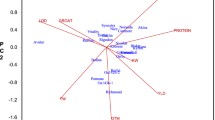Abstract
The linear regression approach has been widely used for selecting high-yielding and stable genotypes targeted to several environments. The genotype mean yield and the regression coefficient of a genotype's performance on an index of environmental productivity are the two main stability parameters. Using both can often complicate the breeder's decision when comparing high-yielding, less-stable genotypes with low-yielding, stable genotypes. This study proposes to combine the mean yield and regression coefficient into a unified desirability index (D i). Thus, D i is defined as the area under the linear regression function divided by the difference between the two extreme environmental indexes. D i is equal to the mean of the ith genotype across all environments plus its slope multiplied by the mean of the environmental indexes of the two extreme environments (symmetry). Desirable genotypes are those with a large D i. For symmetric trials the desirability index depends largely on the mean yield of the genotype and for asymmetric trials the slope has an important influence on the desirability index. The use of D i was illustrated by a 20-environments maize yield trial and a 25-environments wheat yield trial. Three maize genotypes out of nine showed values of D i 's that were significantly larger than a hypothetical, stable genotype. These were considered desirable, even though two of them had slopes significantly greater than 1.0. The results obtained from ranking wheat genotypes on mean yield differ from a ranking based on D i .
Similar content being viewed by others
References
Crossa J (1988) A comparison of results obtained with two methods for assessing yield stability. Theor Appl Genet 75:460–467
Crossa J (1990) Statistical analyses of multilocation trials. Adv Agron 44:55–85
Draper NR, Smith H (1966) Applied regression analysis. John Wiley and Sons, New York
Eberhart SA, Russell WA (1966) Stability parameters for comparing varieties. Crop Sci 6:36–40
Finlay KW, Wilkinson GH (1963) The analysis of adaptation in a plant breeding program. Aust J Agric Res 14:742–754
Freeman GH (1973) Statistical methods for the analysis of genotype-environment interaction. Heredity 31:339–354
Hardwick RC, Wood JT (1972) Regression methods for studying genotype-environment interactions. Heredity 28:209–222
Hill J (1975) Genotype-environment interactions — a challenge for plant breeding. J Agric Sci 85:477–493
Lin CS, Binns MR, Lefkovitch LP (1986) Stability analysis: where do we stand? Crop Sci 26:894–900
Westcott B (1986) Some methods of analyzing genotype-environment interaction. Heredity 56:243–253
Yates F, Cochran WG (1938) The analysis of a group of experiments. J Agric Sci 28:556–580
Author information
Authors and Affiliations
Additional information
Communicated by A. R. Hallauer
Rights and permissions
About this article
Cite this article
Hernandez, C.M., Crossa, J. & Castillo, A. The area under the function: an index for selecting desirable genotypes. Theoret. Appl. Genetics 87, 409–415 (1993). https://doi.org/10.1007/BF00215085
Received:
Accepted:
Issue Date:
DOI: https://doi.org/10.1007/BF00215085




